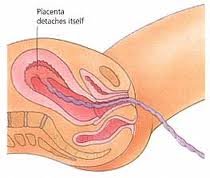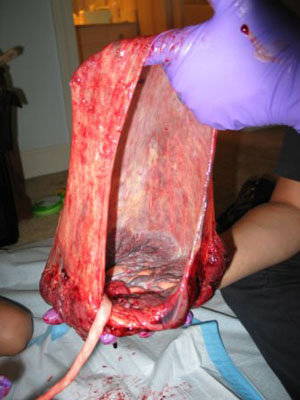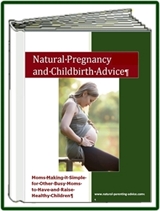Delivery of the Placenta
Delivery of the placenta, known as the third stage of labor, starts immediately after your baby leaves your body and ends when the placenta leaves your body. Here is what you need to know as well as what you should be doing.
When your baby comes out he or she should be placed immediately on your chest skin to skin. Put a blanket or towel over the two of you so baby stays warm. Let her rest and relax a little until she is ready to start looking around and nursing.

Some babies start nursing right away and others need a few minutes. It is ideal if you can have at least 45 minutes of uninterrupted bonding time together. During this time you want your baby to be able to see you and you want your baby to have his or her first nursing.

It is very likely that you will not recall the delivery of the placenta. You will be completely focused on your baby. For this reason, it is important to have a strong birth plan and to have discussed your preferences for third-stage labor ahead of time with your medical attendants.
Make sure that someone is there to make sure you are sitting propped up with pillows so that gravity works in your favor during the delivery of the placenta. If you attended a Bradley Childbirth Method class, your husband will automatically know to do this.
While you are bonding, it is best if the umbilical cord is not cut right away, certainly not until after it has stopped pulsing. During this time, your baby will be eliminating wastes thru the cord (baby jaundice can be caused by early clamping). You also give your baby time to adjust to breathing with his or her lungs while still receiving plenty of oxygen. The cord will continue to provide oxygen to your baby for several minutes after birth, or until it stops pulsing.
What your body is doing
During the delivery of the placenta your uterus continues contracting and, without the baby inside to keep it expended, it deflates like a balloon. As it does, the placenta detaches from uterine wall.
This should not be rushed because you want the placenta to detach cleanly without leaving any of the little “fingers” behind that connected it to your uterus. If they remain, the little “fingers” that were so effective at transferring nutrients from your blood into your baby’s will hold the same blood vessels open and prevent your uterus from being able to shutoff the blood supply. Picture a straw being inserted into a vein. It holds it open rather than letting it collapse and shut the flow down.
The placenta will usually detach completely from the uterine wall within 20 minutes of delivery. You will have contractions during this time that you may not even notice. Breastfeeding your baby will ensure that you have strong, effective afterbirth contractions.
Breastfeeding immediately after birth is nature’s way of nourishing the baby at the same time it lowers the mother’s risk of hemorrhage. It does the same thing as putting pressure on a wound to stop the bleeding.
Hospital personnel often want to rush the delivery of the placenta. They can cause complications by pulling on the cord in an effort to speed the process up. It is a good idea to include your desire to deliver your placenta naturally in your birth plan.
When the placenta has detached, the cord will lengthen a little bit and there may be a small gush of blood. At this point it is fine for them to put a little pressure on the cord while you push during the next contraction to expel the placenta.

The placenta is an amazing thing. It is the only organ that is created after you are born. Your birth attendant will inspect it carefully to make sure that it has been expelled completely and that nothing remains behind in your womb.
If you had any tearing they will stitch you up if required. If you delivered in a hospital, they will move you to a recovery room.
Hospitals are busy, noisy places. We strongly recommend you put a sign on your door asking for the minimum number of interruptions so you can rest, nurse and bond with your baby. We also suggest you limit the number of visitors you have. There is plenty of time for everyone to meet your baby. For the first two weeks after your baby is born you should plan to do nothing other than nurse, care for your baby and sleep when she sleeps.
Quick Links for More Information
Birth Plan Template
Early Signs of Labor
Stages of Labor and Delivery
Early Stage of Labor
Active Labor
Transition
Pushing Stage












New! Facebook Comments
Tell us what you think!